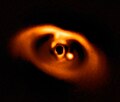Eyeball planet
This article is missing information about more recent modelling of tidally locked worlds disfavoring the formation of eyeball planets in a majority of cases. (April 2024) |
An eyeball planet is a hypothetical type of tidally locked planet, for which tidal locking induces spatial features (for example in the geography or composition of the planet) resembling an eyeball.[1] They are terrestrial planets where liquids may be present, in which tidal locking will induce a spatially dependent temperature gradient (the planet will be hotter on the side facing the star and colder on the other side). This temperature gradient may therefore limit the places in which liquid may exist on the surface of the planet to ring- or disk-shaped areas.
Such planets are further divided into "hot" and "cold" types, depending on which side of the planet the liquid is present. A "hot" eyeball planet is usually closer to its host star, and the centre of the "eye", facing the star (day side), is made of rock while liquid is present on the opposite side (night side). A "cold" eyeball planet, usually farther from the star, will have liquid on the side facing the host star while the rest of its surface is made of ice and rocks.[citation needed]
Because most planetary bodies have a natural tendency toward becoming tidally locked to their host body for a long enough timeline, eyeball planets may be common and could host life, particularly in planetary systems orbiting red and brown dwarf stars which have lifespans much longer than other main-sequence stars.[2]
Potential candidates
[edit]Kepler-1652b is potentially an eyeball planet.[3] The TRAPPIST-1 system may contain several such planets.[4] According to the observations of the James Webb Space Telescope in 2024, the super-Earth[a] planet LHS 1140b might either have a thin ice shell with a subsurface ocean or an icy surface covered partially in liquid water, the latter of which is an attribute of "cold" eyeball planet.[5]
See also
[edit]- Linear settlement – a type of settlement that could be set up on such planets
- Tidal locking
- Extraterrestrial liquid water
- Surface features of exoplanet
- Terrestrial planet
References
[edit]- ^ Starr, Michelle (5 January 2020). "Eyeball Planets Might Exist, And They're as Creepy as They Sound". ScienceAlert.com. Retrieved 6 January 2020.
- ^ Raymond, Sean (20 February 2015). "Forget 'Earth-Like'—We'll First Find Aliens on Eyeball Planets". Nautilus. Archived from the original on 15 December 2021. Retrieved 28 May 2022.
- ^ Tasker, Elizabeth (7 September 2017). The Planet Factory: Exoplanets and the Search for a Second Earth. Bloomsbury Publishing. ISBN 978-1-4729-1775-1.
- ^ Anders, Charlie Jane (13 February 2019). "The Bizarre Planets That Could Be Humanity's New Homes". The Atlantic. Retrieved 10 February 2021.
- ^ "Habitable Zone Exoplanet LHS 1140b is Probably Snowball or Water World". Sci.News. 9 July 2024. Retrieved 10 July 2024.
Notes
[edit]- ^ The mass range of super-Earths is disputed.


 French
French Deutsch
Deutsch

